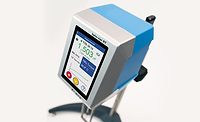Let’s Measure That!
Two new methods of measurement of the molecular structure of polymers and other materials are discussed.

Let’s talk about measurement. In order to understand and design better materials, in order to develop the technology to solve the problems we face today and will face tomorrow, the ability to accurately measure is key.
In my household, measurement has always held an out-sized place in the hierarchy of family concerns. I have a statistician-turned quality engineer-turned data scientist in my home. And because of that, we have spent more than a little time learning how to turn what some would consider mundane tasks into an opportunity to measure, measure, measure. The deck in our backyard was not just assembled. No. its construction was planned – using open-source CAD software – to use every possible inch of wood plank, thus achieving the absolute minimum amount of waste possible. And, there might have been an Easter egg hunt back in the day when certain children learned the fine points of a systematic search in order to optimize the possibility that eggs, hidden in a rather large peach orchard, would be discovered. The latest ways to analyze and measure things are big in my house. That’s why, when I read two recent articles about new ways of measuring molecules, I had to share.
In a recent paper published by the American Chemical Society, researchers at the National Institute of Standards and Technology (NIST) have measured the 3D orientation of the molecular building blocks of polymers, and have observed details as small as 400 nanometers, something that up until now scientists have not had a good way to measure.
The new measurements, according to an article by NIST, “were made using a souped-up version of a technique called broadband coherent anti-Stokes Raman scattering, or BCARS.” With BCARS, researchers will shine laser beams at material, which causes the molecules to vibrate and emit their own light. With this improved technique, NIST research scientist Young Jong Lee has managed to control the polarization of the laser light and developed new mathematical methods to interpret the signal. “Specifically, the new technique measures the average orientation of the polymer chains within 400-nanometer regions, along with the distribution of orientations around that average. These measurements will allow scientists to identify molecular orientation patterns that produce the mechanical, optical and electrical properties they seek,” according to the NIST article.
This research will help material scientists develop medical devices, as the orientation of molecules on the surface of these type of devices are part of what determines how well they bond to materials such as muscle, bone or other tissue. Another application is in additive manufacturing, where material scientists are always trying to develop polymers with better flexibility, strength or heat resistance, among others. The technique could also help in the development of polymer-based ultrathin films that are used in the manufacture of semiconductors. As computer microchips become smaller and smaller, requiring smaller and smaller components, the molecular orientation of these ultrathin polymer films becomes more important.
The other article comes out of Japan, where researchers at Tokyo Tech have managed to observe and characterize dynamic assembly of metallic atoms using a combination of scanning transmission electron microscopy and video-based tracking. Such research opens the possibility of observing more dynamic structures that are predicted by simulations.
The study, led by Associate Professor Takane Imaoka from Tokyo Institute of Technology (Tokyo Tech), was recently published in Nature Communications. A news release from Tokyo Tech explained, “… the team used a combination of video tracking and a technique called ‘annular dark field scanning transmission electron microscopy’ (ADF-STEM) to perform sequential imaging of different metal atoms interacting with one another. This allowed them to directly observe transient structures resulting from an assembly of two similar atoms (homo-metallic dimers), two different atoms ( hetero-metallic dimers), and three different atoms (hetero-metallic trimers).”
Findings from this research could lead to “rapid developments in nanoscience, where the characterization of metal clusters and subnanoparticles is gaining importance, and, in the process, open doors to a completely new realm of matter.”
In measurement information that is closer to home, this edition of ASI includes an article from Kett US about adhesion testing for self-adhesive materials. You will also find an article about the use of pressure-sensitive adhesives in home interior bonding, as well as some interesting research out of the University of Minnesota on a new catalyst that could help in the development of renewable adhesives. And do not miss our previews of the ASC Annual Convention and Expo and Tape Week! The ASC event is coming up in just a few weeks, and Tape Week will be in May. I am excited to see you all at these two important industry events!
Looking for a reprint of this article?
From high-res PDFs to custom plaques, order your copy today!






